A Visit to the Amish of Ethridge, Tennessee (29 Photos)
Don Burke, who’s previously shared photos from places like Kalona, Iowa; Jamesport, Missouri; and an Amish “ghost town”, today takes us to the Ethridge, Tennessee community.

Ethridge is a conservative Swartzentruber community, and depending on how you define the region, the largest Amish settlement in the South.

The people here are decidedly plainer than in communities like Lancaster County or those in northern Indiana. This shows up in many ways including the buggies, homes, and even the simple signs advertising the numerous local businesses.
Don invited a friend to help describe what they found on their visit. I’ll let them take it from here.
—

Don: Genieva (and her husband Ken) have been friends for over two years. In June of 2016 my wife (Pam) and I went to visit these new friends in Tennessee, and while there we spent parts of two days in the Amish settlement at Ethridge.
I’ve invited Genieva to join me in recounting some of the highlights of that trip. So, Genieva, how would you summarize our visit?
Genieva: Well, the Amish in Ethridge were very conservative, and I wouldn’t say they were especially accepting of tourists.

Don: Yeah, I’d have to agree with that. One of the first things we typically notice in an Amish community is the buggies, and here they clearly confirmed that the people are very conservative.

The buggies had no electric lights but used kerosene lanterns instead. (Notice the hook used to hang a lantern on the left outside of the buggy.)

They had no SMV triangle, no windshields, and were very sparse with the reflective tape. Some only had two small strips on the front top corner of the buggy for oncoming traffic to see. We also saw an occasional open buggy.

Don: Homes and home life (including what they wore) weren’t really different from what I’ve seen in many other Amish communities.

Genieva: Their houses were nice but their yards were not as well-kept as some other Amish groups do. And there weren’t any flower gardens.

They had fairly large gardens and many had truck patches and sold produce at a local auction on certain days.

Don: Some of the Amish moved the cook stove outdoors onto a porch during the warm summer months.

Genieva: I thought Mondays were wash day, but it’s Tuesday and look at all the laundry.

Don: Even with their very conservative leanings, the community does allow small gasoline powered motors to run water pumps and other things at home and in their shops.

Genieva: Yeah, we saw pumps with cistern type water-holding tanks. Windmills powered some wells, and some others had gas engines.

One place had a tank that collected the run-off water from the house gutters.

Don: Farming is big in Ethridge. And since our trip was in June, farming was in full-swing.

Don: Shocks from the recent cuttings were everywhere, and the subsequent threshing and storage required all hands on deck.


Don: I was really surprised, though, to see a power cart – a quite large gasoline or diesel engine on a horse-drawn cart that is used to power heavier farming implements (often in tow behind the power cart).

Genieva: Smoking is allowed, and they raise tobacco (a tobacco field is in the foreground, next to this school yard). I didn’t see any tobacco barns so I don’t know if they air cure or dark fire the tobacco leaves.

Don: Speaking of schools, we did see a few of them in the community.

Don: Ethridge has many typical Amish businesses – and with them the typical business signs scattered along the roadside.



Genieva: As we traveled the back roads we kept looking for any signs for something to eat. “Look a sign – Amish Friendship Bread! – let’s stop!”

But no luck – the bread was in the woodstove, baking. “Guess we’ll have to settle for another cracker and peanut butter.”

Genieva: The people at the wood-working shop were friendly. The young man showed us the machinery and demonstrated how they made the some of the pieces they sell. When we left he gave us his business card – a thin piece of wood with a handwritten name and address.

Don: The woman that ran this home business (the small building towards the right) was a little more stand-off-ish, but she did interact with her customers. Her little shop had some interesting items, like special-made brooms, wind-spinners, candy, potholders, soap, candles and other locally-made items.

Don: Another place we stopped was a little one or two room shop that sold jellies and jams and relishes.

Well, folks, that’s Ethridge. Thank you, Genieva, for helping me share our trip. So where shall we all go next?
View more photos from Don’s Ethridge visit.


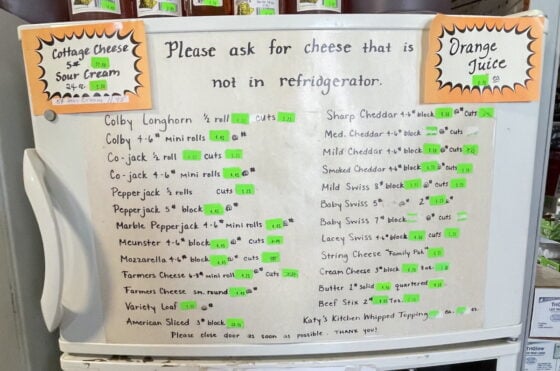
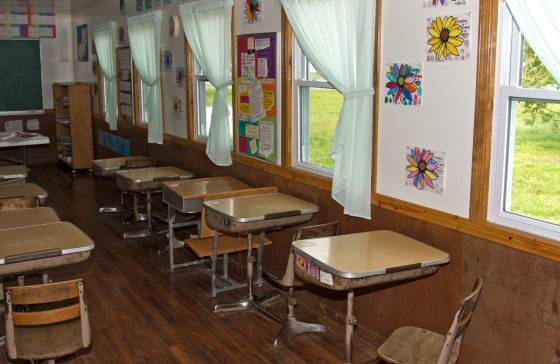
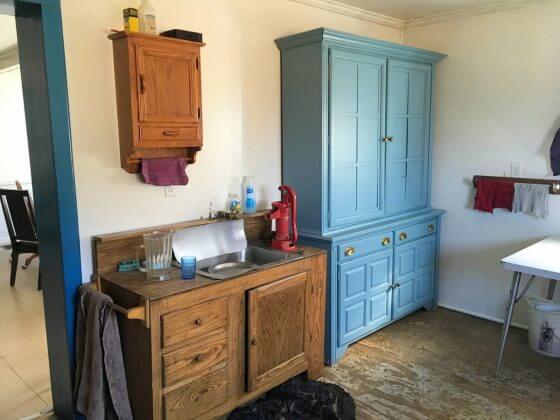
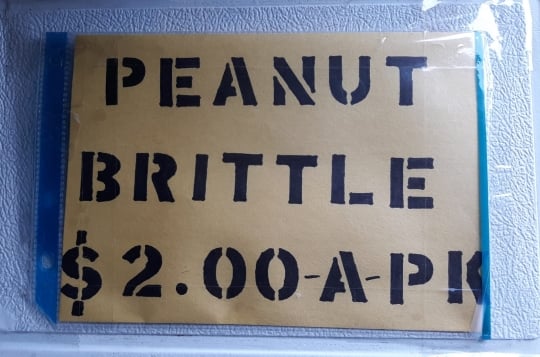
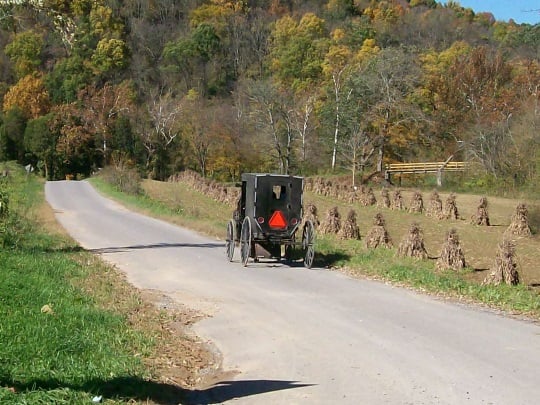
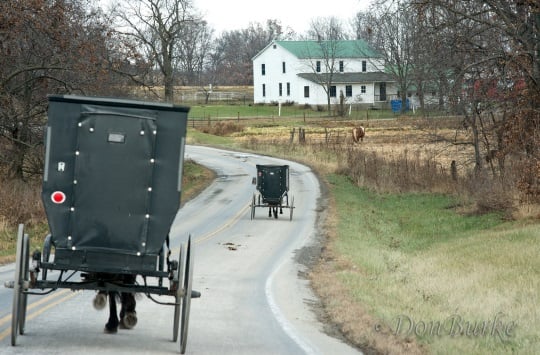
Mr.
I wish that you all would leave the Amish alone, and stop putting them in a Zoo or a pickle jar like some misfit and comparing them to what you think your lifestyle is better.
Roger
No Zoo, No Pickle Jar
Roger, I can’t speak for anyone else, but as the writer and photographer of this article I can assure you that I have great respect for the Amish, and don’t put them in “a zoo” or “pickle jar.” If anyone reads that idea into the above it’s because they brought it with them, not because I put it there.
I am a freelance photographer, and I take something like 50-100k pictures a year — anything from wildlife, to a trip to New England for fall colors, to a cruise to AK, and most recently an interest in the eclipse, moon, and planets. I share those just like I share the Amish pictures — allowing anyone with interest enough to come to a website to view them a chance to share in my experience. This here is nothing more than that very same kind of thing.
reply to Roger Sweatt
I live near this community, and I think the pictures are quite respectful and tasteful. No one’s face is pictured; there is no question of vanity or graven images. Nothing about the article is disrespectful or presents my neighbors as curiosities. I think that with a little more time, the authors could have interviewed some of the people they met; although they are very busy people, they’re not unfriendly, and they have a huge amount of tolerance for the uninformed questions of “English” people. If you are an Amish resident of this community, I concede the point; but it’s not the experience I’ve had, and I lived in Ethridge for 35 years before moving to the other end of the county.
Seeing the washing machine sure did bring back memories. That is like the one my grandmother used when I was a little girl. She would always caution me not to get my fingers near the rollers or they would get smashed!!
Also, in one picture, it looked like a fan in the window. That was a surprise to me.
Thanks to everyone involved in bringing these pictures to us. They truly made my day!!!
Harriet, thank you for your compliments. I’m so glad that I could contribute to making your day brighter.
You mentioned something about a fan in a window in one of the pictures. If it is the picture with the “Baked Goods / Bread” sign in front of the house, yes, it kinda does look like a fan. But I’ve looked at the original (which I can greatly enlarge), and I’m pretty sure that it isn’t a fan after all. But if you’re referring to a different picture, please let me know which one and I will check into it.
October Fest
Don’t forget 2nd Saturday in Oct. Auctions plenty going on. Big deal in Ethridge.
Thanks
Don,
Thanks for all that you share, it allows us to see places that we probably won’t ever go. So good to have someone to share common interests. Will you share with us where we can see more of your photography?
Links to additional pictures...
Sure, I’ll be very happy to point you to some links with my work.
If you are on Facebook, my main photography page is OzarkInspirations, and I also have one dedicated to my Amish-related work call PlainSong. These pages see my new work before anywhere else. The links to these are…
https://www.facebook.com/ozarkinspirations1/
https://www.facebook.com/PlainSong1/
All my photography eventually makes it to my online albums on Flickr. So if you’re interested in what I’ve done in the past, the main link is…
https://www.flickr.com/photos/ozarkinspirations/
…but if you are interested only in my Amish work you can go directly to my Amish collection by using this link…
https://www.flickr.com/photos/ozarkinspirations/collections/
love the Amish in Ethridge TN
My husband and I have been to Ethridge TN several times it is about 3 hours on way from us…the first couple of times that we went the Amish people did not seem to be very sure of us….we always spoke to anyone we saw and they would always speak back….well we would go into what I call small home businesses and I would ask questions like did you cook this? and nine times out of ten that would open to door for us to talk….the women seem to love to tell you all about how to cook, sew, anything that they do they love to share their information as long as you are respectful of them…we have been really blessed to make friends with several of the Amish families up there and we write letters to them and we order things from them often the more that you visit them the more open they will become with you if your wanting to make friends with them just be respectful of their way of life and when you visit be respectful don’t put cell phones and cameras in their faces they don’t like that just try to use your manners and treat them like you would want to be treated and you will see that they are some of the most humble sweet honest Christian people that ya ever want to be around or in Ethridge the families we know sure are they have been a blessing to us for sure love all of our Amish friends
pictures
we visit the amish in Scottsville, ky all summer long.we have done this for over 10 years. we have become friends with them. they know our faces and always helpful in any way. they enjoy talking with us and talk freely
Great pictures and article. My dream is to travel the back ountry through Tennessee, Kentucky and Ohio checking out the road side stands along the way. If I get to live that dream I will include Ethridge.
Always appreciated
Mr. Burke, as usual I want to thank you for using your talent for photography to highlight the Amish way of life (not easy to do, especially with the more conservative groups.) I also appreciated reading about your visit, as I likely won’t ever get to Ethridge myself.
I can’t help but wonder if there are any Amish communities you HAVEN’T been to or photographed? Do you plan an itinerary, or just go where the mood takes you?
Thank you for sharing.
Alice Mary
Don's posts
Alice Mary I won’t jump in to answer for Don, but your question reminded me that we have been getting posts from Don for several years now, and this would be the full list of his contributions for anyone who wants to view others:
https://amishamerica.com/amish-kalona-iowa/
https://amishamerica.com/amish-jamesport-missouri/
https://amishamerica.com/jamesport-school-auction/
https://amishamerica.com/amish-salem-arkansas/
https://amishamerica.com/amish-ava-illinois/
https://amishamerica.com/a-visit-to-an-amish-ghost-town/
https://amishamerica.com/sunday-morning-amish-church-psalms/
https://amishamerica.com/a-visit-to-the-amish-at-garnett-kansas/
https://amishamerica.com/amish-belle-rive-opdyke-illinois/
https://amishamerica.com/a-thanksgiving-visit-to-the-amish-of-clark-missouri/
https://amishamerica.com/amish-canton-missouri/
I don’t think Don has been everywhere yet, but he’s gotten a pretty good start on it 🙂
Thanks...
Sorry to be a little slow in checking back on the thread (still not getting notifications). I appreciate you fielding the question for me, and for mentioning other articles as well.
Not quite yet....
Alice Mary, thank you for your kind words. Sharing my pictures is such a joy for me because of people like you — those who enjoy the chance to see a little of what it is like in places that they may never get the chance to visit in person. Thank you.
Are there any communities that I haven’t been to? Well, at last count I’ve at least passed through and snapped off at least a handful of pictures in something like 50 communities in around a dozen states. While that sounds like (as is) a lot, figures from 2013 say that there were 472 Amish communities in 31 states/provinces. So looks like I still have a long, long way to go. 😉
Ethridge was in the news over the weekend, in what looks like a good ending to a bad story involving the Amish. Two men who were posing as firemen to scam the local Amish were caught:
https://www.lawrenceburgnow.com/093017pair.html
Unfortunately Amish at Ethridge have been the targets of crime more than once over the past several years:
https://amishamerica.com/3-arrested-for-armed-robberies-of-tennessee-amish/
https://amishamerica.com/why-do-criminals-target-the-amish/
More Amish in Tennessee
I noticed that you didn’t have our area listed for Amish communities. Warren County and between Coffee county have several Amish . They have their tack / leather shop, lots of baked goods and services offered,they also sell milk to the public. Super friendly folks as well. We love our Amish neighbors all around us. You should check into this one for sure…
Eldridge Tennessee
I grow up in Chattanooga Tennessee and some of my cousins live out in country. Loved look out mountain. Seeing the ringer washer reminded me of my younger days, my aunt Wilma Dixon used one for out clothes. I live in Hornell,NY now where alot of amish live around me. Love their jams and jellies and produce. Very friendly and beautiful people. Sometimes I miss Tennessee, I remember playing on those dirt roads. Thank you for sharing. Y’all need to visit around my area.
Ethridge, TN, ca. 1965
I graduated from high school in May, 1965. For years, I had subscribed to The Budget and read every edition from cover to cover. As most people, when they graduate from high school, I had at least a 100 dreams, occupations, interests that I thought I could do enjoyably in life.
One of them was caused by often reading in The Budget about the need (and the requests) for teachers in many Amish communities throughout the country. I entered into written communication with a couple of them (especially dear Calvin Anderson and his sister Sarah, my longtime “penpal,” from Holmesville, IN. She and I wrote letters weekly of about 20-30 handwritten pages, with pleasure in sharing our experiences!) and the Amish I contacted were generally accepting of me, though I am not Amish. The closest Amish settlement to my home in Florence, AL, was this one in Ethridge, TN. That is where I fantasied working and living and wished to teach, having “played” as a teacher all throughout my childhood with my sisters and neighbor kids. Back then the publishers of textbooks produced a “teacher’s version” for each text, which I somehow got hold of and relished having and used practically daily in my “teaching.”
Alas, it was Vietnam war time and I was 18 and so I enlisted in the smallest of the military services, the one least likely to force me into fighting battles, namely the US Coast Guard. It was at that time also the service whose recruiters appeared to be the sole ones explicitly seeking “smart” and educated enlisted members, which I felt I was, not just living bodies, and the recruiter agreed, driving personally from Knoxville, TN, to Florence, AL, to pick me up on the very afternoon of my father’s funeral in September, 1965.
Today it is almost exactly 60 years later (I am 78) and my dream of teaching all grades “reading, writing, and arithmetic,” in a one-room Amish schoolhouse, respecting the values and perspectives of the community, is still vivid and something of a regret about the experiences that I chose and was able to accumulate in my adolescence and “youth.”
My affiliation and attraction to the Amish way of life are still powerful and fundamental, though I have outwardly of course not always lived the austerity of this lifestyle as I have moved through my life in many different locales in this wonderful world.
Through your article, it was wonderful to return to those years, ambitions, feelings, beliefs and values. Thank you for this lovely visit to Ethridge, TN. The more things change, the more things stay the same, inside and outside of us.
Dr. Stan De Loach, Diabetologist
Mexico City, Mexico
Correction!
Sorry: Holmesville, OHIO…..NOT Holmesville, INDIANA.